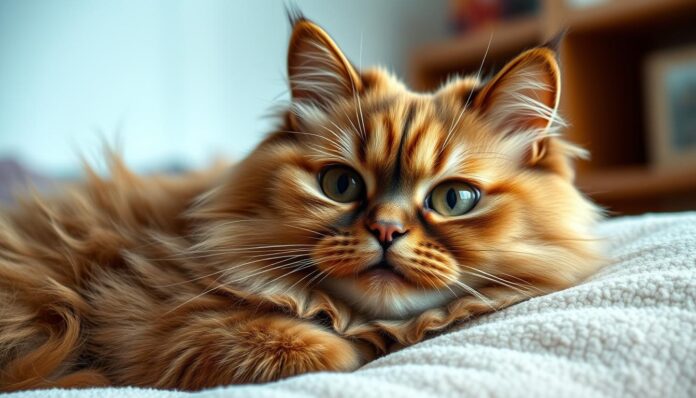The Exotic Shorthair cat has won many hearts. They are known for their luxurious coat and calm nature. This makes them perfect for families.
The Exotic Shorthair breed combines the best of Persian cats with a relaxed vibe. They are friendly and love to show affection. This makes them a wonderful addition to any home.
It’s easy to see why Exotic Shorthair cats are so loved. Their special traits and charming personalities make them a favorite among cat lovers.
The Origins and History of the Exotic Shorthair Breed
The Exotic Shorthair cat breed started in the 1950s and 1960s. It was created by mixing the Persian cat’s calm nature and beautiful coat with the shorthaired cat’s easy grooming. This mix made a cat that was both beautiful and easy to care for.
Development of the Breed in the 1960s
The Exotic Shorthair breed came from crossing Persians with American Shorthairs. This was done to keep the Persian’s calm and looks but make grooming simpler. The result was a cat with the best traits from both sides.
The 1960s were key for the breed’s start. Breeders worked hard to set a breed standard. They focused on looks, personality, and health.
| Year | Event | Significance |
|---|---|---|
| 1950s | Initial breeding experiments | Combining Persian with shorthaired breeds |
| 1960s | Continued development | Establishing breed consistency |
| 1967 | CFA recognition | Official acknowledgment of the breed |
Recognition by Cat Associations
The Exotic Shorthair was recognized by the Cat Fanciers’ Association (CFA) in 1967. This was a big step, showing the breed was accepted by cat lovers. Since then, other big cat registries have also recognized it.
This recognition helped the breeders a lot. It let the Exotic Shorthair show off in cat shows and competitions. This showed its unique qualities to more people.
Physical Characteristics of Exotic Shorthair Cats
Exotic Shorthair cats are known for their cuddly and charming nature. They have a sturdy physique and striking facial features. This makes them a visually appealing companion.
Distinctive Facial Features
Exotic Shorthairs have a short, broad muzzle and large, round eyes. These features give them a sweet expression. Their face is one of their most endearing features, making them popular pets.
Body Structure and Size
These cats have a compact, muscular build. They have a broad chest and strong legs. They are generally medium-sized, making them a manageable pet for many households.
Coat Colors and Patterns
The Exotic Shorthair’s coat is dense and plush, requiring minimal grooming. They come in a wide range of colors and patterns. This ensures there’s an Exotic Shorthair to suit every taste.
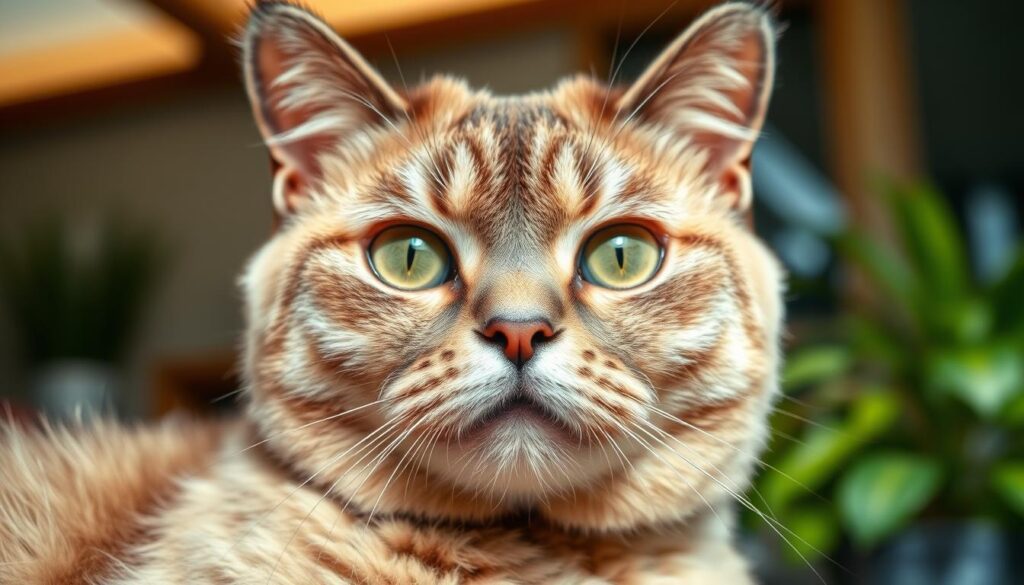
| Characteristic | Description |
|---|---|
| Facial Features | Short, broad muzzle; large, round eyes |
| Body Structure | Compact, muscular build; broad chest |
| Coat | Dense, plush; various colors and patterns |
The Unique Personality of the Exotic Shorthair
The Exotic Shorthair cat breed is known for being calm and affectionate. They make great companions. Their laid-back nature lets them fit well into many homes.
Temperament and Behavior Traits
Exotic Shorthairs are friendly and sociable. They are very gentle and have a “sweet” disposition. This makes them perfect for families with kids or other pets.
Playfulness and Energy Levels
Even though they are calm, Exotic Shorthairs love to play. They enjoy interactive games but don’t need a lot of activity. This suits owners who don’t have time for intense play.
Affection and Bonding with Owners
Exotic Shorthairs bond strongly with their owners. They are affectionate and seek attention. Their ability to form close bonds is why they’re loved by many.
Compatibility with Families and Other Pets
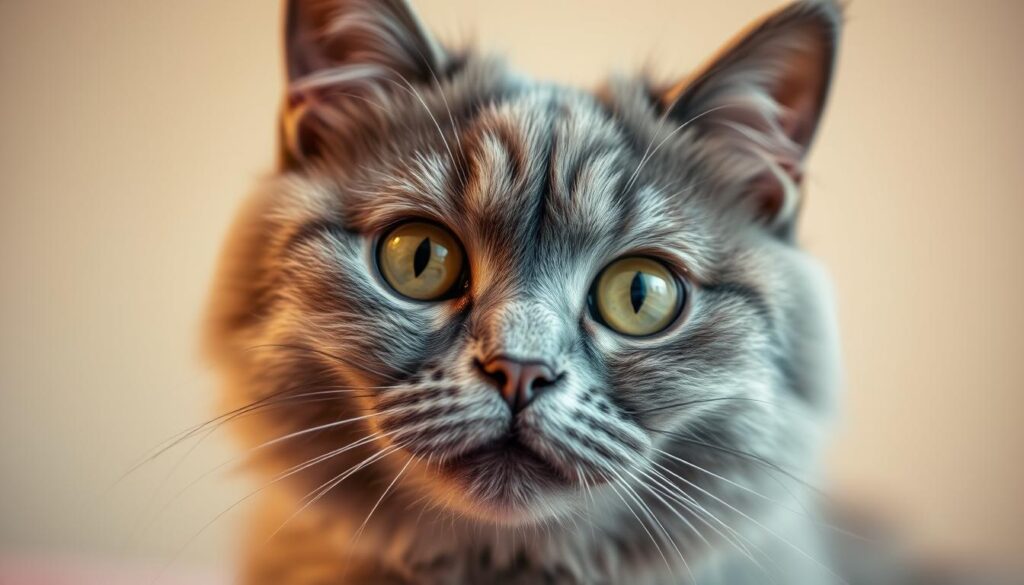
Exotic Shorthairs get along well with families and other pets. Their easy-going nature makes them versatile for different homes. They are not aggressive and usually get along with other animals, especially if socialized early.
The Exotic Shorthair’s unique personality makes them a great addition to many families. Their calm, affectionate, and playful nature has won the hearts of many cat lovers worldwide.
Caring for Your Exotic Shorthair Cat
To keep your Exotic Shorthair cat happy and healthy, you need to know how to care for them. This includes a good diet, regular exercise, and a cozy home.
Dietary Requirements
Exotic Shorthair cats need a balanced diet full of proteins and fats. They also need vitamins and minerals. Choose high-quality cat food without fillers or by-products.
How much to feed depends on your cat’s age, size, and how active they are. Adult Exotic Shorthairs usually eat twice a day. Talk to your vet to find the right food for your cat.
Exercise and Play Needs
Even though they’re calm, Exotic Shorthairs need exercise and play to stay fit. Use toys, climbing structures, and interactive games to keep them active and mentally sharp.
Playing with your cat every day helps prevent obesity and keeps them agile. Short play sessions are fine, making it easy to fit into your busy life.
Creating an Ideal Living Environment
Exotic Shorthairs are perfect for indoor living because they’re calm. It’s important to make their indoor space comfortable and safe.
Indoor vs. Outdoor Considerations
Keeping your Exotic Shorthair indoors keeps them safe from dangers like traffic and diseases. Indoor cats usually live longer and healthier lives.
Temperature Sensitivity
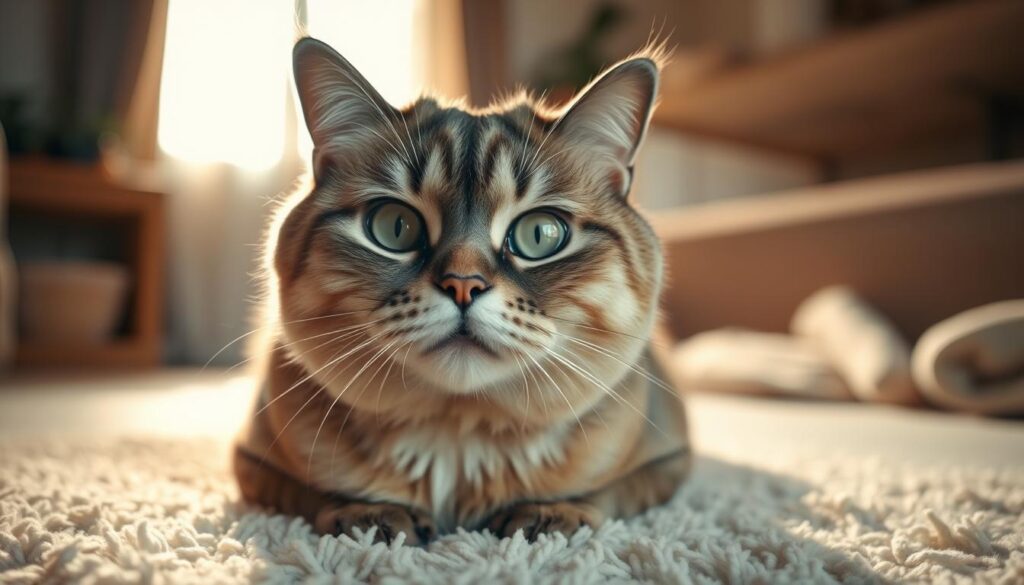
Exotic Shorthairs don’t like extreme temperatures. Keep your home at a comfortable temperature. Avoid letting them get too cold or too hot.
You May Like:- Chausie Cats: Loyal, Intelligent Feline Companions
Exotic Shorthair Grooming Requirements
Exotic Shorthairs need special grooming, even with their short coat. Regular grooming keeps their coat healthy and helps spot health problems early.
Brushing and Coat Maintenance
Exotic Shorthairs have a thick coat that needs brushing to avoid mats. Brush them once or twice a week to keep their coat shiny. Brushing also helps manage their moderate shedding.
Eye and Facial Care
Exotic Shorthairs have flat faces, which can cause tear duct and facial skin problems. Clean their face daily to stop dirt and infections. Check their eyes often for redness or discharge.
Bathing and Nail Trimming
Exotic Shorthairs don’t need baths often, but when they do, use a gentle shampoo. Trim their nails every few weeks to stop them from growing too long.
| Grooming Task | Frequency | Importance |
|---|---|---|
| Brushing | 1-2 times a week | High |
| Eye and Facial Care | Daily | High |
| Bathing | As needed | Medium |
| Nail Trimming | Every few weeks | High |
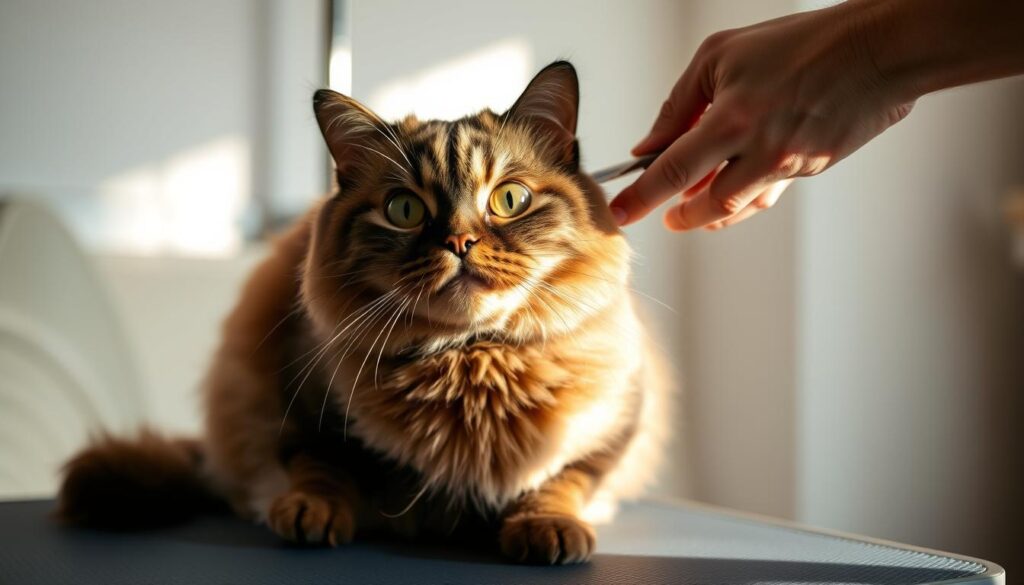
Common Health Issues in Exotic Shorthair Cats
Exotic Shorthairs face health risks due to their brachycephalic breed. Their flat face is beautiful but can cause health problems. Owners need to know these issues to care for their cats well.
Respiratory Concerns
Exotic Shorthairs may have breathing troubles because of their face shape. They might wheeze, cough, or breathe short. It’s important to take them to the vet often to check their breathing.
Keeping your cat at a healthy weight is also key. Extra weight can make breathing harder.
Polycystic Kidney Disease
Polycystic Kidney Disease (PKD) is a genetic issue in Exotic Shorthairs. It causes cysts on the kidneys, which can fail if not treated. Early detection through ultrasound is vital for managing PKD.
Other Genetic Health Considerations
Exotic Shorthairs also face other genetic health problems. These include:
Dental Problems
Their flat face can cause dental crowding and oral health issues. Brushing their teeth and regular vet visits are key to prevent these problems.
Joint and Mobility Issues
Exotic Shorthairs might get joint problems like hip dysplasia. Keeping them at a healthy weight and providing a comfy home can help with these issues.
Knowing about health issues in Exotic Shorthairs helps owners keep them happy and healthy. Regular vet visits, a balanced diet, and a comfy home are essential for their care.
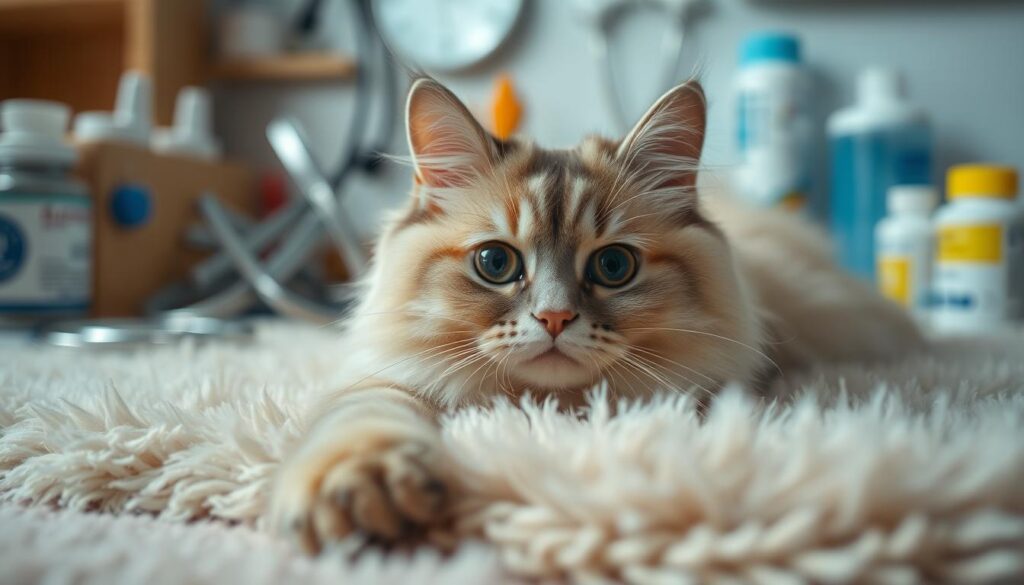
Exotic Shorthair Kittens: What to Expect
Exotic Shorthair kittens are adorable with their fluffy coats and loving nature. They need a caring home to grow up healthy and happy. Knowing their needs is key to giving them the best care.
Early Development Stages
From birth to adulthood, Exotic Shorthair kittens go through many changes. In the first few weeks, they depend on their mom for food and warmth. As they grow, they start to explore and play with their siblings, learning important social skills.
By 8 weeks, kittens are ready to find their forever homes. They need good food, regular vet visits, and a safe place to live to grow well.
| Age | Developmental Milestones | Care Requirements |
|---|---|---|
| 0-4 weeks | Rely on mother, start opening eyes | Ensure mother is healthy, monitor kitten health |
| 4-8 weeks | Start exploring, socializing with littermates | Provide a safe environment, start socialization |
| 8 weeks+ | Ready for adoption, continue socialization | Regular vet check-ups, proper nutrition |
Socialization Tips
Socializing your Exotic Shorthair kitten is very important. Introduce them to different places, people, and pets to help them feel confident and calm. Use treats and praise to encourage good behavior.
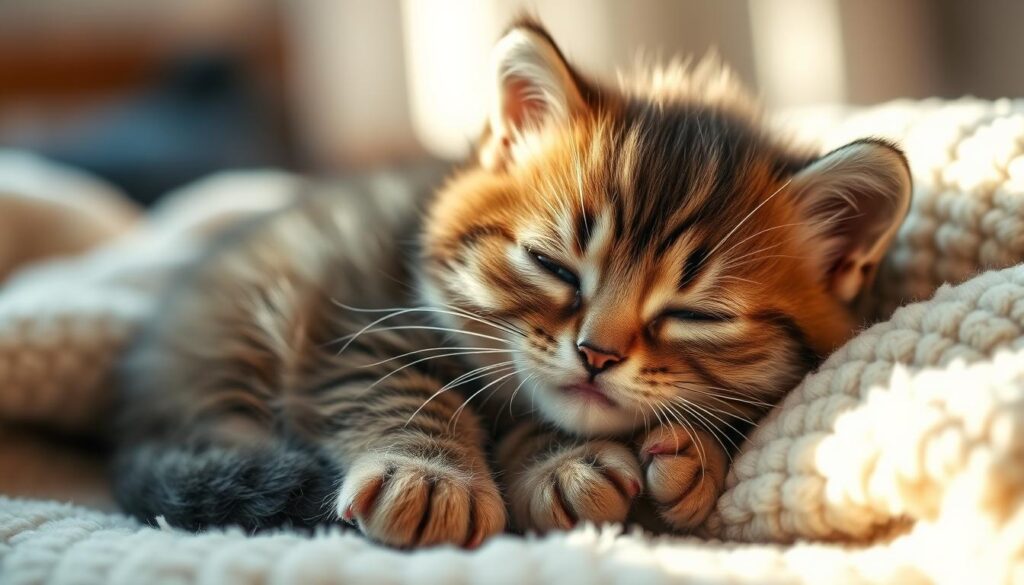
Preparing Your Home for a Kitten
Before your kitten arrives, make sure your home is safe for them. Get rid of dangerous items, keep wires out of reach, and set up a cozy spot for them to rest.
Understanding what your Exotic Shorthair kitten needs and preparing your home will help create a happy and healthy space for them.
Choosing an Exotic Shorthair: Adoption vs. Breeders
Thinking about getting an Exotic Shorthair? You have two main choices: adoption or buying from a breeder. Each option has its pros and cons. It’s important to think carefully before making a decision.
Adoption means giving a loving home to a cat in need. Buying from a reputable breeder ensures you get a cat with known health and lineage.
Finding Reputable Breeders
To find a good breeder, start by looking at local and national cat registries. The International Cat Association is a great place to start. They have directories of breeders near you.
Remember to ask about health clearances for the kitten’s parents. Exotic Shorthairs can have genetic health problems.
Rescue Organizations and Adoption Options
Adopting from a rescue can be very rewarding. Many rescue groups focus on specific breeds, like Exotic Shorthairs. You can find them in your area.
When adopting, learn as much as you can about the cat’s history, personality, and health. This helps ensure you’re a good match.
What to Look for When Selecting Your Cat
Whether you adopt or buy, check the cat’s health and personality. Look for clear eyes, clean ears, and a shiny coat. These are signs of good health.
Health Clearances and Documentation
For breeders, health clearances for the parents are key. This shows they care about the cat’s health, not just making money.
Behavioral Assessment
It’s also important to assess the cat’s behavior. A good Exotic Shorthair should be friendly and not too aggressive or scared.
The Cost of Owning an Exotic Shorthair
Knowing the costs of owning an Exotic Shorthair is key. The expenses can be high, so it’s important to think about them before deciding.
Initial Purchase or Adoption Price
The cost to get an Exotic Shorthair varies. Adoption fees are usually lower, from $50 to $200. Buying from a breeder can cost more, from $600 to $1,500 or more. This depends on the cat’s bloodline and pedigree.
Ongoing Expenses: Food, Healthcare, and Supplies
Exotic Shorthairs need good food, vet visits, and supplies like litter and toys. Food costs $50 to $100 a month. Annual vet care can be $200 to $500.
| Expense Category | Estimated Monthly Cost | Estimated Annual Cost |
|---|---|---|
| Food | $50-$100 | $600-$1,200 |
| Veterinary Care | $0-$50 | $200-$500 |
| Supplies | $20-$50 | $240-$600 |
Insurance and Emergency Fund Considerations
Think about pet insurance and an emergency fund too. Insurance can help with vet bills. An emergency fund gives you peace of mind and financial security.
Understanding the costs of owning an Exotic Shorthair helps you prepare for the financial side of cat ownership.
Exotic Shorthair vs. Persian: Understanding the Differences
Exotic Shorthairs and Persians are similar but have key differences. They are both loved for their unique traits. Knowing these differences is important for those thinking of getting one.
Appearance Comparisons
The main difference is in their coats. Exotic Shorthairs have a short, dense coat that needs less grooming. On the other hand, Persians have a long, flowing coat that requires more care.
Exotic Shorthairs also have a more compact body. Persians, however, are larger and more majestic.
- Coat length: Exotic Shorthair (short) vs. Persian (long)
- Body type: Exotic Shorthair (compact) vs. Persian (larger)
Temperament and Care Differences
Both breeds are calm, but Exotic Shorthairs are more laid-back and easy-going. Persians, however, can be more demanding and need more attention.
Exotic Shorthairs are easier to care for because of their short coats. Persians need regular grooming to avoid matting.
Conclusion: Is an Exotic Shorthair Right for You?
Exotic Shorthair cats have won many hearts with their cute looks and loving nature. They mix a calm temperament with playful charm, making them perfect companions for the right person.
Thinking about getting an Exotic Shorthair? You should know their care needs. They need regular grooming, a healthy diet, and watching out for health issues. Even though they’re easy-going, they still need your care.
Looking for a cat that’s both gentle and fun? The Exotic Shorthair might be perfect. They’re calm, great for families with kids or other pets, as long as you introduce them carefully. Knowing what Exotic Shorthairs need helps you decide if they’re right for you.
So, if you’re ready to care for them, an Exotic Shorthair can add joy and friendship to your life. For many, the answer to “is Exotic Shorthair right for me” is a clear “yes.”
FAQ
What is the average lifespan of an Exotic Shorthair cat?
Exotic Shorthair cats live between 12 to 15 years. This depends on their diet, health, and where they live.
Are Exotic Shorthairs good with children?
Yes, they are calm and gentle, perfect for families. But, it’s important to teach kids how to handle them gently.
Do Exotic Shorthairs require a lot of grooming?
They have a short coat that needs regular brushing. They also need baths and nail trims to stay clean.
Are Exotic Shorthairs prone to any specific health issues?
They might get respiratory problems, polycystic kidney disease, and other genetic issues. Regular vet visits and tests can catch these early.
How much does an Exotic Shorthair kitten cost?
Prices vary based on the breeder, bloodline, and location. Expect to pay 0 to
FAQ
What is the average lifespan of an Exotic Shorthair cat?
Exotic Shorthair cats live between 12 to 15 years. This depends on their diet, health, and where they live.
Are Exotic Shorthairs good with children?
Yes, they are calm and gentle, perfect for families. But, it’s important to teach kids how to handle them gently.
Do Exotic Shorthairs require a lot of grooming?
They have a short coat that needs regular brushing. They also need baths and nail trims to stay clean.
Are Exotic Shorthairs prone to any specific health issues?
They might get respiratory problems, polycystic kidney disease, and other genetic issues. Regular vet visits and tests can catch these early.
How much does an Exotic Shorthair kitten cost?
Prices vary based on the breeder, bloodline, and location. Expect to pay $600 to $1,500 for a pet-quality kitten.
Can Exotic Shorthairs be left alone for extended periods?
They need attention and interaction. Leaving them alone for too long can cause boredom and stress.
How often should I feed my Exotic Shorthair?
They can get fat easily, so watch their food intake. Feed them a balanced diet based on their age, size, and activity level.
Are Exotic Shorthairs compatible with other pets?
They usually get along with other pets if socialized early. Introduce new pets slowly and carefully.
Do Exotic Shorthairs shed a lot?
They shed moderately due to their short, dense coat. Brushing them regularly can help reduce shedding.
Can Exotic Shorthairs be trained?
Yes, they are smart and can learn with positive reinforcement. They can learn basic commands and behaviors.
,500 for a pet-quality kitten.
Can Exotic Shorthairs be left alone for extended periods?
They need attention and interaction. Leaving them alone for too long can cause boredom and stress.
How often should I feed my Exotic Shorthair?
They can get fat easily, so watch their food intake. Feed them a balanced diet based on their age, size, and activity level.
Are Exotic Shorthairs compatible with other pets?
They usually get along with other pets if socialized early. Introduce new pets slowly and carefully.
Do Exotic Shorthairs shed a lot?
They shed moderately due to their short, dense coat. Brushing them regularly can help reduce shedding.
Can Exotic Shorthairs be trained?
Yes, they are smart and can learn with positive reinforcement. They can learn basic commands and behaviors.


